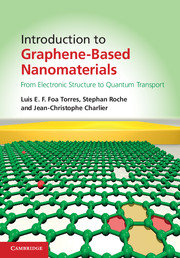Book contents
- Frontmatter
- Contents
- Preface
- 1 Introduction to carbon-based nanostructures
- 2 Electronic properties of carbon-based nanostructures
- 3 Quantum transport: general concepts
- 4 Klein tunneling and ballistic transport in graphene and related materials
- 5 Quantum transport in disordered graphene-based materials
- 6 Quantum transport beyond DC
- 7 Ab initio and multiscale quantum transport in graphene-based materials
- 8 Applications
- Appendix A Electronic structure calculations: the density functional theory (DFT)
- Appendix B Electronic structure calculations: the many-body perturbation theory (MBPT)
- Appendix C Green's functions and ab initio quantum transport in the Landauer–Büttiker formalism
- Appendix D Recursion methods for computing the DOS and wavepacket dynamics
- References
- Index
4 - Klein tunneling and ballistic transport in graphene and related materials
Published online by Cambridge University Press: 05 February 2014
- Frontmatter
- Contents
- Preface
- 1 Introduction to carbon-based nanostructures
- 2 Electronic properties of carbon-based nanostructures
- 3 Quantum transport: general concepts
- 4 Klein tunneling and ballistic transport in graphene and related materials
- 5 Quantum transport in disordered graphene-based materials
- 6 Quantum transport beyond DC
- 7 Ab initio and multiscale quantum transport in graphene-based materials
- 8 Applications
- Appendix A Electronic structure calculations: the density functional theory (DFT)
- Appendix B Electronic structure calculations: the many-body perturbation theory (MBPT)
- Appendix C Green's functions and ab initio quantum transport in the Landauer–Büttiker formalism
- Appendix D Recursion methods for computing the DOS and wavepacket dynamics
- References
- Index
Summary
In this chapter we start with a presentation of the so-called Klein tunneling mechanism, which is one of the most striking properties of graphene. Later we give an overview of ballistic transport both in graphene and related materials (carbon nanotubes and graphene nanoribbons). After presenting a simple real-space mode-decomposition scheme, which can be exploited to obtain analytical results or to boost numerical calculations, we discuss Fabry-Pérot interference, contact effects, and the minimum conductivity in the 2D limit.
The Klein tunneling mechanism
The Klein tunneling mechanism was first reported in the context of quantum electrodynamics. In 1929, physicist Oskar Klein (Klein, 1929) found a surprising result when solving the propagation of Dirac electrons through a single potential barrier. In non-relativistic quantum mechanics, incident electrons tunnel a short distance through the barrier as evanescent waves, with exponential damping with the barrier depth. In sharp contrast, if the potential barrier is of the order of the electron mass, eV ~ mc2, electrons propagate as antiparticles whose inverted energy–momentum dispersion relation allows them to move freely through the barrier. This unimpeded penetration of relativistic particles through high and wide potential barriers has been one of the most counterintuitive consequences of quantum electrodynamics, but despite its interest for particle, nuclear, and astro-physics, a direct test of the Klein tunnel effect using relativistic particles still remains out of reach for high-energy physics experiments.
- Type
- Chapter
- Information
- Introduction to Graphene-Based NanomaterialsFrom Electronic Structure to Quantum Transport, pp. 118 - 142Publisher: Cambridge University PressPrint publication year: 2014



